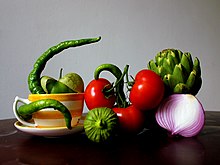
Apache still life. c.1907 by Edward S. Curtis.

A modern-day still life photo with red tomatoes
تصوير الطبيعة الصامتة
Still life photography
من ويكيبيديا

طبيعة صامتة، 1890 م
التصوير الفوتوغرافي للطبيعة الصامتة (بالإنجليزية: Still life photography)، هو تصوير أي من الجمادات أو النباتات في غير بيئتها الطبيعية، وكل ماهو غير حي في وضع الثبات داخل الأستوديو في ظروف تم التحكم بها مسبقاً بغية الوصول لصيغة فنية معينة وتوصيل أفكار معينة من خلال الصورة الفوتوغرافية. تختلف الحياة الصامتة في تكوينها الفني عن الطبيعة الحية، ويستخدم هذا النوع بكثرة لتصوير الإعلانات لأنها تحتاج إلى الوقت الكافي والدقة والعناية في اختيار العناصر. وقديماً استخدم المصريون القدماء هذا النوع من التصوير لتزيين جدران المعابد.
Still life photography
From Wikipedia,
Still life photography is a genre of photography used for the depiction of inanimate subject matter, typically a small group of objects. Similar to still life painting, it is the application of photography to the still life artistic style.[1] Tabletop photography, product photography, food photography, found object photography etc. are examples of still life photography.[2]
This genre gives the photographer more leeway in the arrangement of design elements within a composition compared to other photographic genres, such as landscape or portrait photography. Lighting and framing are important aspects of still life photography composition.
Manmade objects like pots, vases, consumer products, handicrafts etc. or natural objects like plants, fruits, vegetables, food, rocks, shells etc. can be taken as subjects for still life photography.[2] Typically, still life photos are not close up to the subject nor far away, but at a very head-on angle. The art in still life photography is often in the choice of objects that are being arranged and the lighting rather than the skill of the photographer.
The J. Paul Getty Museum, Los Angeles, mounted the exhibition “In Focus: Still Life” in 2010.[3] The exhibition included works by still life photographers such as Paul Outerbridge, Paul Strand, André Kertész, Albert Renger-Patzsch, Josef Sudek, Jan Groover, Sharon Core, and Martin Parr.
References

تعليق